Papers by Viktor Tsyganov
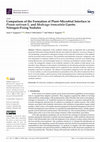
International Journal of Molecular Sciences
Different components of the symbiotic interface play an important role in providing positional in... more Different components of the symbiotic interface play an important role in providing positional information during rhizobial infection and nodule development: successive changes in cell morphology correspond to subsequent changes in the molecular architecture of the apoplast and the associated surface structures. The localisation and distribution of pectins, xyloglucans, and cell wall proteins in symbiotic nodules of Pisum sativum and Medicago truncatula were studied using immunofluorescence and immunogold analysis in wild-type and ineffective mutant nodules. As a result, the ontogenetic changes in the symbiotic interface in the nodules of both species were described. Some differences in the patterns of distribution of cell wall polysaccharides and proteins between wild-type and mutant nodules can be explained by the activation of defence reaction or premature senescence in mutants. The absence of fucosylated xyloglucan in the cell walls in the P. sativum nodules, as well as its pred...
Agronomy
The production of high-value, environmentally friendly and healthy food has been the major global... more The production of high-value, environmentally friendly and healthy food has been the major global focus of sustainable agriculture in recent years [...]

Ecological genetics
Cadmium (Cd) is one of the most wide-ranged and dangerous pollutants for all living organisms, i... more Cadmium (Cd) is one of the most wide-ranged and dangerous pollutants for all living organisms, including plants. At present time the intensive studies of mechanisms of Cd accumulation in plant tissues and plant tolerance to its toxic influence are performed. Data about variation of Cd tolerance and accumulation traits in natural populations of hyperaccumulators species as well as important crops were obtained. A series of mutants with changed sensitivity to Cd was obtained. In recent decade several classes of proteins involving in cell responses to Cd ions were revealed. An important role of microRNA in plant adaptation to Cd was recently demonstrated. Studies of molecular-genetic mechanisms of Cd accumulation and plant tolerance to it are theoretical basis for development of phytoremediation technologies of soil contaminated with heavy metals and breeding of crop varieties with decreased Cd accumulation.

Symbiosis
Legumes possess by unique possibility to interact with soil proteobacteria, known as rhizobia, fo... more Legumes possess by unique possibility to interact with soil proteobacteria, known as rhizobia, forming on the roots the special organs called symbiotic nodules, where nitrogen fixation takes place. To form the nodule, rhizobia should penetrate inside root tissue, where they colonize a nodule primordium, formed from the reactivated root cells. One of the ways of root infection by rhizobia occurs via formation of a transcellular tubular structure, termed infection thread (IT), which grows through the cytoplasm by apical deposition of primary cell wall material. Numerous mutants impaired in the infection thread development were obtained in different legumes. Genetic analysis has revealed that mutants belong to different complementation groups; this means the existence of precise genetic control over infection thread development. Moreover, it was suggested that infection and nodule organogenesis are regulated with independent but coordinated genetic programs. Using the model legumes, a set of plant genes, controlling infection thread development was identified. These genes encode transcriptional factors, LysM receptor kinases, E3 ubiquitin ligases, SCAR/WAVE actin regulatory complex, nitrate transporter, remorins, flotillins, proteins involved in membrane biogenesis and traffic, and some other components. In this review, we briefly summarized our current knowledge about genetic control over developmental processes associated with infection thread.
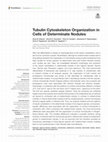
Frontiers in Plant Science
Plant cell differentiation is based on rearrangements of the tubulin cytoskeleton; this is also t... more Plant cell differentiation is based on rearrangements of the tubulin cytoskeleton; this is also true for symbiotic nodules. Nevertheless, although for indeterminate nodules (with a long-lasting meristem) the organization of microtubules during nodule development has been studied for various species, for determinate ones (with limited meristem activity) such studies are rare. Here, we investigated bacteroid morphology and dynamics of the tubulin cytoskeleton in determinate nodules of four legume species: Glycine max, Glycine soja, Phaseolus vulgaris, and Lotus japonicus. The most pronounced differentiation of bacteroids was observed in G. soja nodules. In meristematic cells in incipient nodules of all analyzed species, the organization of both cortical and endoplasmic microtubules was similar to that described for meristematic cells of indeterminate nodules. In young infected cells in developing nodules of all four species, cortical microtubules formed irregular patterns (microtubule...
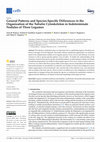
Cells
The tubulin cytoskeleton plays an important role in establishing legume–rhizobial symbiosis at al... more The tubulin cytoskeleton plays an important role in establishing legume–rhizobial symbiosis at all stages of its development. Previously, tubulin cytoskeleton organization was studied in detail in the indeterminate nodules of two legume species, Pisum sativum and Medicago truncatula. General as well as species-specific patterns were revealed. To further the understanding of the formation of general and species-specific microtubule patterns in indeterminate nodules, the tubulin cytoskeleton organization was studied in three legume species (Vicia sativa, Galega orientalis, and Cicer arietinum). It is shown that these species differ in the shape and size of rhizobial cells (bacteroids). Immunolocalization of microtubules revealed the universality of cortical and endoplasmic microtubule organization in the meristematic cells, infected cells of the infection zone, and uninfected cells in nodules of the three species. However, there are differences in the endoplasmic microtubule organizat...

Sel'skokhozyaistvennaya Biologiya, 2017
Nitrogen-fixing nodules are formed on the roots of leguminous plants as a result of their interac... more Nitrogen-fixing nodules are formed on the roots of leguminous plants as a result of their interaction with soil bacteria, called rhizobia. Nodule development is based on the exchange of signaling molecules that leads to coordinated gene expression in both partners. This process is accompanied by differentiation of both plant and bacterial cells leading to formation of infected plant cells, filled with nitrogen-fixing forms of rhizobia, called bacteroids. The bacteroid is separated from the plant cell cytoplasm by the peribacteroid membrane and forms an organelle-like structure called the symbiosome (A.V. Tsyganova et al., 2017). The main function of the symbiotic nodule is to maintain the microaerophilic conditions required for working of the rhizobial nitrogen fixation enzymenitrogenase, which is extremely sensitive to oxygen. Nitrogen-fixing nodules produce an abundance of reactive oxygen species (ROS) and reactive nitrogen species (RNS). These are formed due to auto-oxidation of leghemoglobin in the cytoplasm, oxidation of nitrogenase and ferredoxin in symbiosomes, and functioning of electron transport chains in mitochondria, symbiosomes, and peroxisomes (C. Chang et al., 2009). ROS and RNS molecules are involved in different signal transduction pathways; therefore, the nodule antioxidant system cannot simply eliminate ROS and RNS, but must maintain their concentration in the cell at the certain level (C.W. Ribeiro et al., 2015). Most antioxidants presented in plant organs are also found in the nodule, however, at a higher concentration, which is probably due to the high intensity of the processes associated with biological nitrogen fixation. These are enzymes superoxide dismutase, ascorbate peroxidase, glutathione peroxidase, and peroxiredoxins, as well as millimolar concentrations of non-enzymatic elements (primarily ascorbic acid and glutathione) (M. Becana et al., 2010). It has been discovered that Legumes harbor a unique homologue of glutathione, homoglutathione, both of which exhibit similar functions and specificity. However, it is still not clear why some Legumes evolved the ability to synthesize two different thiol compounds and require a double regulatory mechanism of the cell cycle including activation by glutathione and inhibition of cytokinesis by homoglutathione (T. Pasternak et al., 2014). It has now been shown that an increase in the level of glutathione leads to an increase in the efficiency of nitrogen fixation, while there is no similar data for homoglutathione. Considering that for the functioning of the nodule a balance in the ratio of glutathione and homoglutathione is necessary, it is evident that increasing the level of nitrogen fixation by modifying the levels of these thiols is a non-trivial task. Moreover, it is necessary to account for the influence of other components of the antioxidant system. It should be noted that the rhizobial antioxidants play an important role in the functioning of the nitrogen fixing nodule (C.W. Ribeiro et al., 2015). In this review, we will consider the main components of the plant antioxidant system in the nodule. A deeper understanding of its functioning is necessary to develop conditions for increasing the efficiency of biological nitrogen fixation.
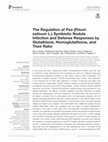
Frontiers in Plant Science, 2022
In this study, the roles of glutathione (GSH), homoglutathione (hGSH), and their ratio in symbiot... more In this study, the roles of glutathione (GSH), homoglutathione (hGSH), and their ratio in symbiotic nodule development and functioning, as well as in defense responses accompanying ineffective nodulation in pea (Pisum sativum) were investigated. The expression of genes involved in (h)GSH biosynthesis, thiol content, and localization of the reduced form of GSH were analyzed in nodules of wild-type pea plants and mutants sym33-3 (weak allele, “locked” infection threads, occasional bacterial release, and defense reactions) and sym33-2 (strong allele, “locked” infection threads, defense reactions), and sym40-1 (abnormal bacteroids, oxidative stress, early senescence, and defense reactions). The effects of (h)GSH depletion and GSH treatment on nodule number and development were also examined. The GSH:hGSH ratio was found to be higher in nodules than in uninoculated roots in all genotypes analyzed, with the highest value being detected in wild-type nodules. Moreover, it was demonstrated, ...
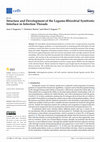
Cells, 2021
The intracellular infection thread initiated in a root hair cell is a unique structure associated... more The intracellular infection thread initiated in a root hair cell is a unique structure associated with Rhizobium-legume symbiosis. It is characterized by inverted tip growth of the plant cell wall, resulting in a tunnel that allows invasion of host cells by bacteria during the formation of the nitrogen-fixing root nodule. Regulation of the plant-microbial interface is essential for infection thread growth. This involves targeted deposition of the cell wall and extracellular matrix and tight control of cell wall remodeling. This review describes the potential role of different actors such as transcription factors, receptors, and enzymes in the rearrangement of the plant-microbial interface and control of polar infection thread growth. It also focuses on the composition of the main polymers of the infection thread wall and matrix and the participation of reactive oxygen species (ROS) in the development of the infection thread. Mutant analysis has helped to gain insight into the develo...

Sel'skokhozyaistvennaya Biologiya, 2014
Senescence is the natural stage in development of symbiotic nodule. As a result of senescence, re... more Senescence is the natural stage in development of symbiotic nodule. As a result of senescence, reutilization of different nutrients from nodule to the other plant organs occurs. Generally senescence in legumes is triggered after flowering finishing, although the first traits of senescence can be observed very early during nodule development. A delay of the triggering of senescence program will allow to prolong the active nitrogen-fixating period and therefore to increase the amount of symbiotrophic nitrogen in plants and, finally, to elevate legume productivity. That is why no wonder that in the recent years the senescence of nitrogen-fixing nodules is actively studied. In this review the main developmental stages of nitrogen-fixing symbiotic nodule of legumes, particularities of symbiotic nodule development of determinate and indeterminate types are considered. In legumes with indeterminate nodules, the symbiosomes are not long-leaving as the infected tissues are permanently renewing due to apical meristem. There are two subsequent stages identified in an indeterminate nodule senescent. First a bacteroid degradation and the death of some infected cells occur, and then both symbiosomes and all infected cells are destroyed. In determinate nodules, the senescence initiated in the central part of a nodule, then extends to the peripheral zone. In this review morphological characters of nodule senescence at ulatrstructural level are analyzed. The role of cysteine and threonine proteases is discussed. Reutilization of nitrogen and other products of protein degradation are probably the most important during senescence. There are the evidences that in the root nodules of legumes the cysteine proteases are involved into nodule functions, adaptation of the host plant cells to physiological stresses, and the nodule senescence control. By a large-scale analysis of nodule transcriptome of Medicago truncatula Gaertn. several groups of genes expressed at successive stages of the senescence of indeterminate nodule are revealed. In this review the role of phytohormones, such as ethylene, abscisic acid, jasmonic acid, gibberellins and nitrogen monooxide in senescence of symbiotic nodule is considered. Nevertheless, until recent days our knowledge about hormonal control of nodule senescence is still incomplete. The oxidative stress, accompanying the process of nodule senescence is discussed. On the nodule aging, the concentrations of peroxides, protein carbonyls, modified DNA nucleotides and catalytic Fe increase. Iron activates lipids peroxidation in a peribacteroid space, resulting in degradation of the peribacteroid membrane in senescent nodules. The concentrations of oxidized glutathione and homoglutathione rise significantly during the nodule development, and the reduced forms decrease under senescence, indicating an oxidative stress in the senescing nodules. In this review the role of genes, encoding proteins involved in transport of wide-range of molecules, and genes, whose products are involved in regulatory and signal functions in cell; differences between stress-induced senescence and natural senescence are considered. Using model legumes, Lotus japonicus (Regel) K. Larsen and M. truncatula, several genes were cloned the mutations of which caused early senescence. It is emphasized that these genes encode different proteins involved into functioning of a symbiotic nodule. Until now, two transcription factors in M. truncatula are described, which are involved into nodule senescence. An induced senescence is more rapid, comparing to natural senescence, and manifests the signs of an oxidative stress and programmed cell death.
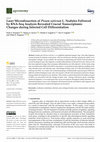
Agronomy, 2021
Garden pea (Pisum sativum L.) is a globally important legume crop. Like other legumes, it forms b... more Garden pea (Pisum sativum L.) is a globally important legume crop. Like other legumes, it forms beneficial symbiotic interactions with the soil bacteria rhizobia, gaining the ability to fix atmospheric nitrogen. In pea nodules, the meristem is long-lasting and results in the formation of several histological zones that implicate a notable differentiation of infected host cells. However, the fine transcriptional changes that accompany differentiation are still unknown. In this study, using laser microdissection followed by RNA-seq analysis, we performed transcriptomic profiling in the early infection zone, late infection zone, and nitrogen fixation zone of 11-day-old nodules of pea wild-type line SGE. As a result, a list of functional groups of differentially expressed genes (DEGs) in different nodule histological zones and a list of genes with the most prominent expression changes during nodule development were obtained. Their analyses demonstrated that the highest amount of DEGs wa...

Agronomy, 2021
Chinese liquorice (Glycyrrhiza uralensis Fisch. ex DC.) is widely used in the food industry and a... more Chinese liquorice (Glycyrrhiza uralensis Fisch. ex DC.) is widely used in the food industry and as a medicine. Like other legumes, G. uralensis forms symbiotic nodules. However, the structural organization of G. uralensis nodules is poorly understood. In this study, we analyzed the histological and ultrastructural organization and dynamics of the tubulin cytoskeleton in various cells from different histological zones of indeterminate nodules formed by two strains of Mesorhizobium sp. The unusual walls of infection threads and formation of multiple symbiosomes with several swollen bacteroids were observed. A large amount of poly-β-hydroxybutyrate accumulated in the bacteroids, while the vacuoles of meristematic and uninfected cells contained drop-shaped osmiophilic inclusions. Immunolocalization of the tubulin cytoskeleton and quantitative analysis of cytoskeletal elements revealed patterns of cortical microtubules in meristematic, infected and uninfected cells, and of endoplasmic mi...
Abstract book of the 2nd International Scientific Conference "Plants and Microbes: the Future of Biotechnology" PLAMIC2020, 2020
The interaction of legumes with rhizobia leads to formation of the symbiotic nodules on their roo... more The interaction of legumes with rhizobia leads to formation of the symbiotic nodules on their roots, which are specialized plant organs for nitrogen fixation. Considerable progress has been made in deciphering the molecular-genetic and cellular mechanisms of symbiotic nodule development in recent years. However, some aspects of nodule development clearly merit much more attention.
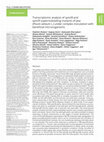
Biological Communications, 2021
The garden pea (Pisum sativum L.), like most members of Fabaceae family, is capable of forming sy... more The garden pea (Pisum sativum L.), like most members of Fabaceae family, is capable of forming symbioses with beneficial soil microorganisms such as nodule bacteria (rhizobia), arbuscular mycorrhizal (AM) fungi and plant growth promoting bacteria (PGPB). The autoregulation of nodulation (AON) system is known to play an important role in controlling both the number of nodules and the level of root colonization by AM via root-to-shoot signaling mediated by CLAVATA/ESR-related (CLE) peptides and their receptors. In the pea, mutations in genes Sym28 (CLV2-like) and Sym29 (CLV1-like), which encode receptors for CLE peptides, lead to the supernodulation phenotype, i.e., excessive nodule formation. The aim of the present study was to analyze the response of pea cv. ‘Frisson’ (wild type) and mutants P64 (sym28) and P88 (sym29) to complex inoculation with rhizobia, AM fungi and PGPB, with regard to biomass accumulation, yield and transcriptomic alterations. The plants were grown in quartz sa...
Sel'skokhozyaistvennaya Biologiya, 2017

Sel'skokhozyaistvennaya Biologiya, 2015
The process of symbiotic nodule formation resulting from interaction between legume plants and rh... more The process of symbiotic nodule formation resulting from interaction between legume plants and rhizobia is controlled by both partners. From the plant side the important role belongs to a system of hormonal regulation, involving all classes of phytohormones identified in plants. Negative regulation of nodulation is very important for the plant since the symbiotic nodule formation is highly energy-consuming process. Moreover, nodules lacking nitrogen fixation might be formed during interaction with ineffective strain of rhizobia, and it is disadvantageous for the plant. Up to now, there are data about involving of four phytohormones into negative regulation of nodule formation: ethylene, abscisic, jasmonic and salicylic acids. In this review, the role of ethylene in negative regulation of nodulation is discussed. Ethylene negatively regulates the number of developing symbiotic nodules at different stages of their formation. The first negative effect of ethylene appears at the level of calcium spiking, triggered by Nod actors produced by rhizobia. Further, ethylene negatively influences deformations of roots hairs, stimulated by Nod factors, infection thread growth, as well as nodule primordium development. In tropical legume Sesbania rostrata Bremek. & Oberm. ethylene represses the activity of nodule meristem, leading to formation of determinate type of nodule (with temporal meristem activity), while at the absence of ethylene indeterminate nodules (with prolonged meristem activity) are formed. At the same time, it was found that in soybean Glycine max (L.) Merr., ethylene is not involved in regulation of nodulation. It seems that ethylene involvement into regulation of nodule formation is not strictly dependent on the type of nodules, since in the other legume plants, forming determinate nodules, number of nodules is negatively affected by ethylene. It is suggested that ethylene synthesis in inoculated roots is triggered by Nod factors, which activate plant defense responses, leading to restriction of number of forming nodules. Hypernodulating mutant of Medicago truncatula Gaertn. sickle, carrying a mutation in the gene MtEIN2, which is the key component in ethylene signal transduction pathway, is characterized by decreased level of defense response activation, as it was shown by proteomic analysis. It is interesting that not only the plants, but rhizobia as well can control ethylene level in rhizosphere and therefore influence nodule number. One of such mechanisms is the synthesis of rhizobitoxin by some rhizobial strains, which has structural similarity with inhibitor of ethylene synthesis aminoethoxyvinilglycine (AVG). The other mechanism is more widespread among rhizobia and it deals with synthesis of ACC deaminase, an enzyme, which cleaves the precursor of ethylene synthesis 1-aminocyclopropane-1-carboxylic acid (ACC). Thus, regulation of ethylene level may be important for practical application, potentially allowing to increase plant's ability to nodulation. However, it should be taken into account that nodule number is precisely regulated by the plant because nodule formation is very energy-consuming process. Even more, it is necessary to remember that ethylene stimulates development of root hairs and decrease of their level may influence an intake ability of root and lead to deficiency of nutrient elements.

Fine mapping of a cdt locus mutation that leads to an increase in the tolerance of pea (Pisum sativum L.) to cadmium
Russian Journal of Genetics: Applied Research, 2013
The SGECdt pea mutant (cdt), which has an increased level of cadmium accumulation and tolerance t... more The SGECdt pea mutant (cdt), which has an increased level of cadmium accumulation and tolerance to cadmium as compared to the initial line, was recently created. Earlier, a sequence specific amplified polymorphism analysis detected the location of the cdt locus in pea linkage group VI. For mapping of the cdt locus in more detail, a set of molecular markers that was based on the known sequences of pea genes was developed. The sequences were determined using the analysis of genome microsynteny between pea and the model legume Medicago truncatula. A close linkage between the cdt locus and the markers elaborated on the base of Pentatricopeptide repeat and Exosome complex exsonuclease RRP45 genes was revealed. Thus, the prerequisites for further cdt positional cloning were developed.

Plants
In Russia, tetramethylthiuram disulfide (TMTD) is a fungicide widely used in the cultivation of l... more In Russia, tetramethylthiuram disulfide (TMTD) is a fungicide widely used in the cultivation of legumes, including the pea (Pisum sativum). Application of TMTD can negatively affect nodulation; nevertheless, its effect on the histological and ultrastructural organization of nodules has not previously been investigated. In this study, the effect of TMTD at three concentrations (0.4, 4, and 8 g/kg) on nodule development in three pea genotypes (laboratory lines Sprint-2 and SGE, and cultivar ‘Finale’) was examined. In SGE, TMTD at 0.4 g/kg reduced the nodule number and shoot and root fresh weights. Treatment with TMTD at 8 g/kg changed the nodule color from pink to green, indicative of nodule senescence. Light and transmission electron microscopy analyses revealed negative effects of TMTD on nodule structure in each genotype. ‘Finale’ was the most sensitive cultivar to TMTD and Sprint-2 was the most tolerant. The negative effects of TMTD on nodules included the appearance of a senescen...
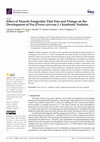
International Journal of Molecular Sciences
Triazole fungicides are widely used in agricultural production for plant protection, including pe... more Triazole fungicides are widely used in agricultural production for plant protection, including pea (Pisum sativum L.). The use of fungicides can negatively affect the legume-Rhizobium symbiosis. In this study, the effects of triazole fungicides Vintage and Titul Duo on nodule formation and, in particular, on nodule morphology, were studied. Both fungicides at the highest concentration decreased the nodule number and dry weight of the roots 20 days after inoculation. Transmission electron microscopy revealed the following ultrastructural changes in nodules: modifications in the cell walls (their clearing and thinning), thickening of the infection thread walls with the formation of outgrowths, accumulation of poly-β-hydroxybutyrates in bacteroids, expansion of the peribacteroid space, and fusion of symbiosomes. Fungicides Vintage and Titul Duo negatively affect the composition of cell walls, leading to a decrease in the activity of synthesis of cellulose microfibrils and an increase i...

Analysis of the expression of polyamine biosynthesis genes in nodules of the garden pea (Pisum sativum L.) and the effect of exogenous treatment with polyamines on their development
Ecological genetics
BACKGROUND: Polyamines are acting as signaling molecules during adaptation to stressful environme... more BACKGROUND: Polyamines are acting as signaling molecules during adaptation to stressful environment and as regulators of plant development. In plants, polyamines are represented mainly by putrescine, spermidine and spermine. The concentration of polyamines in symbiotic nodules of some legumes is 510 times higher than in the other organs, which indicates their important role in the formation and functioning of symbiotic nodules. MATERIALS AND METHODS: We analyzed the expression of genes encoding polyamine biosynthesis enzymes in symbiotic nodules, as well as the effect of exogenous polyamines on the nodule number and the average nodule weight in wild-type SGE plants and symbiotic pea mutants SGEFix-1 (sym40-1) and SGEFix-2 (sym33-3). RESULTS: The comparable expression level of arginine decarboxylase gene (PsADC) was observed in all analyzed nodules, whereas the expression level of ornithine decarboxylase gene (PsODC), was highly increased in nodules of SGEFix-2 (sym33-3) mutant. Trea...











Uploads
Papers by Viktor Tsyganov